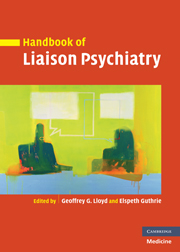Book contents
- Frontmatter
- Contents
- List of contributors
- Preface
- Part I Basic skills
- Part II Common psychiatric problems across the general hospital
- Part III Working with specific units
- 14 Neurological disorders
- 15 Cardiorespiratory disorders
- 16 Gastrointestinal disorders
- 17 Liver disorders
- 18 Endocrine disorders
- 19 Diabetes
- 20 HIV and AIDS
- 21 Renal disease
- 22 Musculo-skeletal disorders
- 23 Oncology
- 24 Head and neck cancer
- 25 Palliative care
- 26 Cosmetic procedures
- 27 Perinatal and gynaecological disorders
- 28 The intensive care unit
- 29 The burns unit
- 30 Psychocutaneous disorders
- 31 Genitourinary disorders
- 32 The emergency department
- Part IV Treatment
- Part V Different treatment settings
- Index
- References
27 - Perinatal and gynaecological disorders
from Part III - Working with specific units
Published online by Cambridge University Press: 10 December 2009
- Frontmatter
- Contents
- List of contributors
- Preface
- Part I Basic skills
- Part II Common psychiatric problems across the general hospital
- Part III Working with specific units
- 14 Neurological disorders
- 15 Cardiorespiratory disorders
- 16 Gastrointestinal disorders
- 17 Liver disorders
- 18 Endocrine disorders
- 19 Diabetes
- 20 HIV and AIDS
- 21 Renal disease
- 22 Musculo-skeletal disorders
- 23 Oncology
- 24 Head and neck cancer
- 25 Palliative care
- 26 Cosmetic procedures
- 27 Perinatal and gynaecological disorders
- 28 The intensive care unit
- 29 The burns unit
- 30 Psychocutaneous disorders
- 31 Genitourinary disorders
- 32 The emergency department
- Part IV Treatment
- Part V Different treatment settings
- Index
- References
Summary
Introduction
The interface between obstetrics, gynaecology and psychiatry is complex. All women require access to obstetric or gynaecological services via primary care or hospital specialists at some point in their lives. It is likely that the only medical care many women have received is associated with aspects of their reproductive health. Their experience is not of illness and the need for medical intervention, but of a necessary contact in the setting of their general wellbeing. However, women are repeatedly subject to intimate and often painful examination in the context of wellness. Added to this, matters of sexual health, sexual behaviour, fertility and childbirth are sensitive, open to inappropriate judgement and fraught with difficult choices, whilst being inextricably set within a culture that may be different for each woman. Reproductive choices have been profoundly influenced by recent technologies and interventions. These increase the choices (and the risks) for women and provide a complex interplay between the social and the personal.
More than ever, clinicians in obstetric/gynaecological (OB/GYN) settings need to be aware of the potential psychological implications of normal reproductive events across a woman's life. They are also increasingly called upon to work together with psychiatrists in the care of women with existing mental health problems. These women do not necessarily experience different outcomes of reproductive health. For some mentally ill women, their reproductive lives may represent an opportunity to take part in community life in a way that features of their illness may otherwise prevent.
Keywords
- Type
- Chapter
- Information
- Handbook of Liaison Psychiatry , pp. 632 - 672Publisher: Cambridge University PressPrint publication year: 2007

